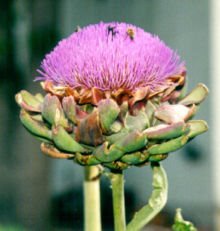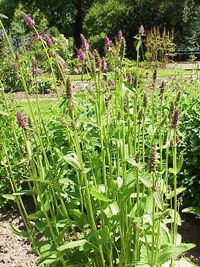 This is what the plant looks like (I saw a BUNCH of these when I drove up the coast highway in CA in January)
This is what the plant looks like (I saw a BUNCH of these when I drove up the coast highway in CA in January)I found most of these facts on Wikipedia
There are 3 common types of "Artichokes"
Globe (the one we all think of when we say artichoke)
Jerusalem
Chinese
Globe (the most common)

A member of the thistle family (daisy and sunflowers).
We eat the flower bud before it blossoms.
History

Globe Artichokes were first cultivated at Naples around the middle of the 15th century, and are said to have been introduced to France by Catherine de Medici, in the 16th century. they were growing in Henry VIII's garden at Newhall in 1530. They were introduced to the United States19th century, to Louisiana by French immigrants and to California by Spanish immigrants
Where they are grown
Virtually 100 percent of all artichokes grown commercially in the United States are grown in California. Castroville, a town with a population of a little more than 5,000 and located in Monterey County, is the self-proclaimed "Artichoke Center of the World" because three-fourths of all California artichokes are grown in this area. (source)
The closer you are to Castro, CA the fresher your artichokes are.
How to choose a good Artichoke (I actually got this from an episode of Good Eats I own- Alton Brown knows his stuff!)
Size= Large navel orange. It should seem heavy for it's size
Color- a little more tricky. If it's spring they are light green with purple, summer olive drab color.
The best indicator are the leaves. You want your artichoke to have tightly packed leaves (not all spread out). Also, test a leaf by folding it in half. If it snaps, it's fresh. You don't want a rubbery leafed artichoke!
And try to get the longest stem possible (when cooked they taste similar to the heart)
The Two Less Common "artichokes"
Jerusalem

The Jerusalem artichoke has no relation to Jerusalem, and little to do with artichokes.
Instead of eating the flower of this plant (like with the globe artichoke), the roots are eaten. The artichoke part of the Jerusalem artichoke's name comes from its taste, which is a cross between a radish and a artichoke.
Chinese

The Chinese artichoke or knotroot is distinctly rare.
The Chinese artichoke is easy to grow but it's rare because it's not easy to cook with.
In China, the Chinese artichoke is used primarily for pickling.
There ya have it. More than you ever wanted to know about ARTICHOKES. I actually know a little more so if you have any questions, shoot away : )



8 comments:
Artichokes are now on my "to eat" list. I haven't had one in years. Now I gotta get hoppin'!
I can't think of any questions, just wanted to thank you for another interesting post. I LOVE artichokes!!!!
Huggs and BFN, G
i didn't know the flower was so beautiful when it bloomed!! a gorgeous purple. i also have never seen what artichokes look like when they're growing. how interesting!
I love artichokes... when I was a little girl it was on my list of favorite foods (Still is actually)
The flower is so pretty.
My kids don't like artichokes.. which I fathom.
i just learned that my artichoke will bloom and i have to pick it before it flowers.
sounds kinda mean but soooo delicious! with lemoned vegannaise. yum.
What a lovely bunch of artichokes!
:)
Thanks for the positive thoughts/comments you left earlier today...
veggin'out has a bunch of new things happening!
ahem...i believe I was the one that did that driving up the coast. thank you
-;p
I absolutely adore artichokes and think every backyard should grow some. Whoever first decided to try eating the thorny thistle was a brave cook indeed. Thanks for your FUN blog!
http://mindycooks.blogspot.com
Post a Comment